This is a short, sensible, straightforward book for the non-sleep-specialist that summarizes a good deal of what is known about disordered sleep in children and adolescents. It is well written and well referenced for those who want to chase down the details of the studies cited in support of the text.
Stores has done a great service in providing this guidebook for pediatricians who want a quick reference to match a patient’s, or parent’s, complaint against the diagnostic features he outlines and the case summaries that illustrate each of the disorders in turn. The book is particularly good at including the family context in understanding the issues that may be involved in the origin and/or maintenance of these disorders, as well as how they may affect the plan for treatment. He is very aware that the state of knowledge about sleep disorders, particularly as they appear in children, is not as fully developed as we would like. He understands that the same diagnosis may have different symptom presentations in children than in adults. Disorders such as narcolepsy, which is manifest as daytime sleepiness in adults, may show as hyperactivity in youngsters. In addition, an overlap in the symptom pictures may make a clear diagnosis difficult, posing questions such as, Is this a seizure disorder or a parasomnia? How does one sort out whether an episodic oversleeper is suffering from Klein-Levin syndrome, has a bipolar variant, or is suffering from the aftermath of some infectious disease?
Although the research into sleep disorders of children lags far behind that of adults, this book gives a lot of information to both parents and physicians that is helpful to their understanding of these problems. For physicians, the book is a guide for working up the patient for sleep problems that they may not have recognized previously as well as advice on which require further overnight sleep testing. Stores has clearly had extensive experience with these problems, which gives him the mastery to convey this information in an organized format that makes it easy to find and follow. The book has an extensive glossary of terms that makes the text accessible to the general reader. The index is particularly well done, and the references are up-to-date as of 2000. Altogether this is a valuable contribution, which one hopes will serve as a stimulus for better care of the children and adolescents who struggle with sleep problems. Such problems are often ignored, with serious consequences to the child’s education, self-esteem, social life, physical development, and health.

